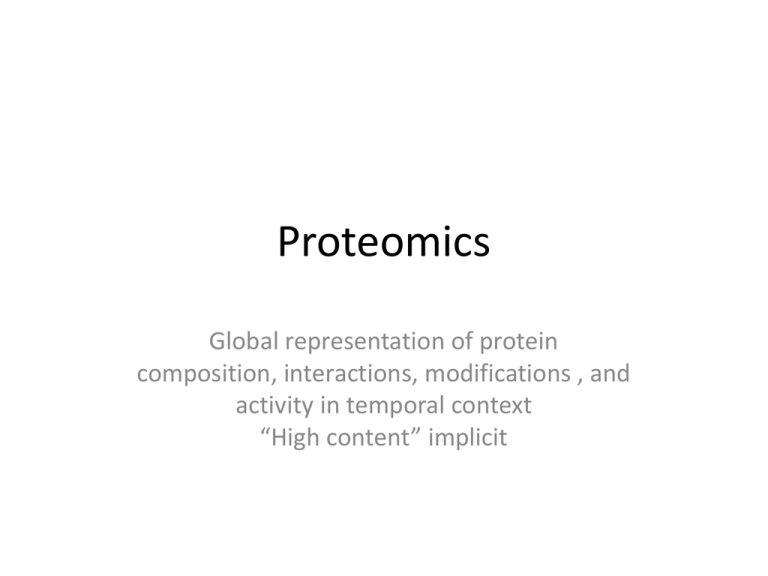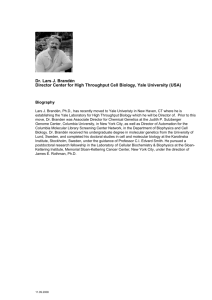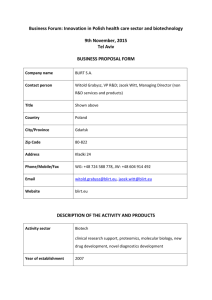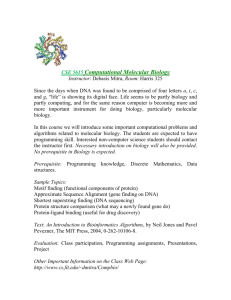Proteomics
advertisement

Proteomics Global representation of protein composition, interactions, modifications , and activity in temporal context “High content” implicit Approaches • High resolution separation – SDS PAGE 1-2D – IEF – Multidimensional LC • Arrays – Protein – Antibody • Multiplex – Luminex – Aptamers • Mass spectrometry MS based proteomic work flow MS Sample Process Ionize Determine mass Process Ions Process Data Ionization methods for peptides Electrospray ionization (ESI) Matrix assisted laser desorption ionization (MALDI) Beam mass analysers 2:140 (2003) Trapping mass analysers a) Quadrupole ion trap b) Fourier transform ion cyclotron resonance Schematic of the LTQ Orbitrap Velos MS instrument with three new hardware implementations. Olsen J V et al. Mol Cell Proteomics 2009;8:2759-2769 ©2009 by American Society for Biochemistry and Molecular Biology QqTOF Layout Peptide Fragmentation Adv Protein Chemistry & Structural Biology, Vol. 80, 1-44, 2010 Archives of Physiology and Biochemistry, 2009; 115(5): 311–319 Tandem Mass Spectrometry (MSMS) Molecular Systems Biology 2008 4:222 Proteins: Considerations • • • • • • • Virtually any source Free from degradation Minimal unintroduced chemical modifications Quantity a few micrograms Concentration mg/ml Free from inhibitory materials (e.g. SDS, salts) Dynamic range of materials Separation Approaches • Separation methods – 1-2 D PAGE – Multidimensional LC – Capillary electrophoresis – Affinity • • • • Antibody Lectin Substrate cofactor PTM Gel separated Proteins 2D SDS PAGE • Strengths – fair resolution – Meta data • size and isoelectric point • Molecular heterogeneity (PTMs) • Limitations – – – – – Load Solubility Isoelectric point extremes molecular size variability 2D Difference Gel electrophoresis (DIGE) AppliedBiomics.com Nat. Inst. Aging iTRAQ—Isobaric Tags for Relative and Absolute Quantification Multiple tag types available from different commercial sources. Numbers tags/kit constantly rising. Adv Protein Chemistry & Structural Biology, Vol. 80, 1-44, 2010 Comparison of SILAC and iTRAQ SILAC iTRAQ Basis of labelling Biosynthetic Chemical Sample labelling Simple Labour intensive Requirements Active metabolism Proteins Defined media Proteins Multiplexing Yes Yes Signal Diluted Single ID Inference some times Confirmed Potential for Bias low higher Reutilisation Not applicable Cellular capacity Not applicable Induction of Podocalyxin in EMT Frequency Frequency 800 700 600 500 400 300 200 100 0 -8 -6 -4 -2 0 2 4 6 8 10 Log(Ratio) base 2 Log2Control ratio Control TGF Beta - TGFβ1 TGF 72h + TGFβ1 Combine SDS PAGE LC MS/MS PTM Analysis 14:35 (2013) Selected Reaction Monitoring • Targeted for selected analytes. • Not a discovery approach for protein identification • Increases sensitivity 30-50 fold • Qualitative or quantitative • Offers multiplexing capacity 20-30 analytes per run Selected Reaction Monitoring Activity based protein profiling Unlabelled Inactive enzyme Labelled Active enzyme Probes available for many categories of enzymes e.g. serine hydrolase, cysteine proteases, ubiquitinase Normal Nan Li , Herman S Overkleeft , Bogdan I Florea Activity-based protein profiling: an enabling technology in chemical biology research Current Opinion in Chemical Biology 16:227 2012 Lethal 2.55 Å crystal structure of SOMAmer SL1025 bound to human IL-6 (form 2 chains A and B). Gelinas A D et al. J. Biol. Chem. 2014;289:8720-8734 ©2014 by American Society for Biochemistry and Molecular Biology




